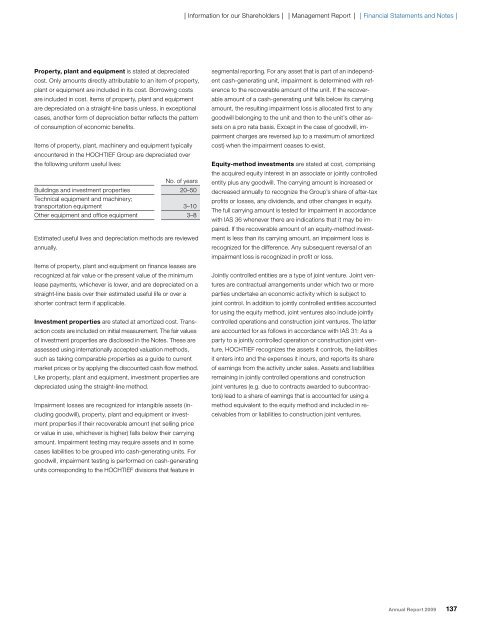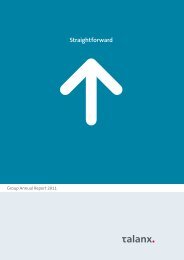ONE ROOF
ONE ROOF
ONE ROOF
You also want an ePaper? Increase the reach of your titles
YUMPU automatically turns print PDFs into web optimized ePapers that Google loves.
Property, plant and equipment is stated at depreciated<br />
cost. Only amounts directly attributable to an item of property,<br />
plant or equipment are included in its cost. Borrowing costs<br />
are included in cost. Items of property, plant and equipment<br />
are depreciated on a straight-line basis unless, in exceptional<br />
cases, another form of depreciation better reflects the pattern<br />
of consumption of economic benefits.<br />
Items of property, plant, machinery and equipment typically<br />
encountered in the HOCHTIEF Group are depreciated over<br />
the following uniform useful lives:<br />
No. of years<br />
Buildings and investment properties<br />
Technical equipment and machinery;<br />
20–50<br />
transportation equipment<br />
3–10<br />
Other equipment and office equipment 3–8<br />
Estimated useful lives and depreciation methods are reviewed<br />
annually.<br />
Items of property, plant and equipment on finance leases are<br />
recognized at fair value or the present value of the minimum<br />
lease payments, whichever is lower, and are depreciated on a<br />
straight-line basis over their estimated useful life or over a<br />
shorter contract term if applicable.<br />
Investment properties are stated at amortized cost. Trans-<br />
action costs are included on initial measurement. The fair values<br />
of investment properties are disclosed in the Notes. These are<br />
assessed using internationally accepted valuation methods,<br />
such as taking comparable properties as a guide to current<br />
market prices or by applying the discounted cash flow method.<br />
Like property, plant and equipment, investment properties are<br />
depreciated using the straight-line method.<br />
Impairment losses are recognized for intangible assets (in-<br />
cluding goodwill), property, plant and equipment or invest-<br />
ment properties if their recoverable amount (net selling price<br />
or value in use, whichever is higher) falls below their carrying<br />
amount. Impairment testing may require assets and in some<br />
cases liabilities to be grouped into cash-generating units. For<br />
goodwill, impairment testing is performed on cash-generating<br />
units corresponding to the HOCHTIEF divisions that feature in<br />
❘ Information for our Shareholders ❘ ❘ Management Report ❘ ❘ Financial Statements and Notes ❘<br />
segmental reporting. For any asset that is part of an independent<br />
cash-generating unit, impairment is determined with reference<br />
to the recoverable amount of the unit. If the recoverable<br />
amount of a cash-generating unit falls below its carrying<br />
amount, the resulting impairment loss is allocated first to any<br />
goodwill belonging to the unit and then to the unit’s other assets<br />
on a pro rata basis. Except in the case of goodwill, impairment<br />
charges are reversed (up to a maximum of amortized<br />
cost) when the impairment ceases to exist.<br />
Equity-method investments are stated at cost, comprising<br />
the acquired equity interest in an associate or jointly controlled<br />
entity plus any goodwill. The carrying amount is increased or<br />
decreased annually to recognize the Group’s share of after-tax<br />
profits or losses, any dividends, and other changes in equity.<br />
The full carrying amount is tested for impairment in accordance<br />
with IAS 36 whenever there are indications that it may be impaired.<br />
If the recoverable amount of an equity-method investment<br />
is less than its carrying amount, an impairment loss is<br />
recognized for the difference. Any subsequent reversal of an<br />
impairment loss is recognized in profit or loss.<br />
Jointly controlled entities are a type of joint venture. Joint ven-<br />
tures are contractual arrangements under which two or more<br />
parties undertake an economic activity which is subject to<br />
joint control. In addition to jointly controlled entities accounted<br />
for using the equity method, joint ventures also include jointly<br />
controlled operations and construction joint ventures. The latter<br />
are accounted for as follows in accordance with IAS 31: As a<br />
party to a jointly controlled operation or construction joint venture,<br />
HOCHTIEF recognizes the assets it controls, the liabilities<br />
it enters into and the expenses it incurs, and reports its share<br />
of earnings from the activity under sales. Assets and liabilities<br />
remaining in jointly controlled operations and construction<br />
joint ventures (e.g. due to contracts awarded to subcontractors)<br />
lead to a share of earnings that is accounted for using a<br />
method equivalent to the equity method and included in receivables<br />
from or liabilities to construction joint ventures.<br />
Annual Report 2009 137
















